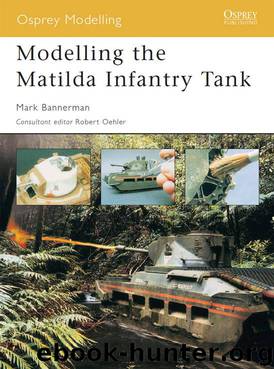Modelling the Matilda Infantry Tank (Osprey Modelling) by Bannerman Mark

Author:Bannerman, Mark [Bannerman, Mark]
Language: eng
Format: azw3
Tags: Modelling the Matilda Infantry Tank
ISBN: 9781780969909
Publisher: Bloomsbury Publishing
Published: 2012-06-19T16:00:00+00:00
The fuel-tank mounts were added using sheet styrene, and the rear tow-hook links were glued in place. (SD)
All placement holes on the hull were filled with putty and sanded down. Small deck details were added, such as the small latches at the rear of the engine deck made from plastic rod and sheet plastic. On the front of the hull, Sean added a shovel and a pick handle. These items were secured using parts from the Eduard set and from the spares box. (SD)
A rear view of the assembled model. (SD)
Moving up to the front, there is the driver’s vision port: the opening was drilled out and the kit’s visor added. The sidelight protector boxes located on the left and right fenders were replaced with the Eduard offerings and plastic rod was used for the two protection arms located just in front of the boxes. The spare track brackets are simply flat plastic stock cut to size and three spare links from the Friulmodel track set were added. The right front fender holds a mirror bracket. Sean chose to only add the bracket, not the mirror.
Most photos depicting wartime Matildas show the mirrors removed. For the headlights, there are several options. One can use the Tamiya offerings, as these are standard blackout lights found on most military vehicles throughout the war. Or, one can hollow out the lights and add aftermarket lenses. Tank crews would turn the lights around so that they would be facing the hull, which would have helped prevent them from being damaged in battle and, more importantly, stop any reflection that would give away the tank’s position to the enemy.
Wiring for the lights is not necessary, as the wires run through the light mounting brackets. One could also use some lead foil and cover the headlights, making it look like a canvas cover. The front tow hooks were replaced using spares from the parts box and some scratchbuilt plates using plastic card and Grandt Line bolt heads. Looking closely at wartime pictures will help with both placement and sizing.
At this stage of assembly, one can put the upper and lower hulls together. The front of the tank requires new weld seams. Sean made them by soaking plastic rod in liquid cement to soften the rod and then placing these in position. This method is extremely effective, because these would naturally be rough in texture. Small cuts are necessary where the welds jump the front stowage bins. This cut is directly in line with the hinges.
Moving to the rear of the hull, Sean added scratch-built mufflers. The kit items can be used, but he used brass tube cut to length, and then plugged both ends with plumber’s putty. Once sanded flat, .005-sized plastic card was wrapped around the brass tube, leaving about 1mm protruding from the ends to give the necessary indentation. Small kit exhaust outlets were added. The brackets holding the mufflers together were made using square plastic stock and sheet brass.
The exhaust pipes leading from the engine to the mufflers were then added.
Download
This site does not store any files on its server. We only index and link to content provided by other sites. Please contact the content providers to delete copyright contents if any and email us, we'll remove relevant links or contents immediately.
On Writing A Memoir of the Craft by Stephen King(4864)
The Doodle Revolution by Sunni Brown(4689)
A Simplified Life by Emily Ley(4099)
Mummy Knew by Lisa James(3634)
Marijuana Grower's Handbook by Ed Rosenthal(3623)
Better Homes and Gardens New Cookbook by Better Homes & Gardens(3527)
Figure Drawing for Artists by Steve Huston(3384)
Paper Parties by Erin Hung(3371)
Draw Your Day by Samantha Dion Baker(3290)
The Genius of Japanese Carpentry by Azby Brown(3226)
Japanese Design by Patricia J. Graham(3112)
The Code Book by Simon Singh(3077)
Dangerous Girls by Haas Abigail(2980)
Lions and Lace by Meagan Mckinney(2925)
The Curated Closet by Anuschka Rees(2915)
How to Make Your Own Soap by Sally Hornsey(2830)
The Checklist Manifesto by Atul Gawande(2780)
The Wardrobe Wakeup by Lois Joy Johnson(2733)
Zero to Make by David Lang(2726)
